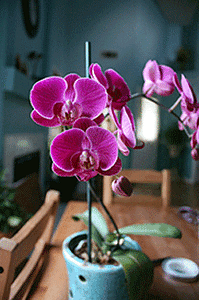 It can be tricky to tell when it’s time to repot your Phalaenopsis orchid. So beware!
It can be tricky to tell when it’s time to repot your Phalaenopsis orchid. So beware!
The typical repotting signs we watch for in other houseplants don’t apply to Phalaenopsis orchids.
- Roots that protrude above the soil surface or creep over the pot edge usually indicate a seriously pot-bound plant in desperate need of repotting. However, what are considered symptoms of distress in most houseplants are normal behavior for Phalaenopsis orchids in the wild: Epiphyte orchids, Phalaenopsis orchids cling to tree branches high above the forest floor of their tropical homeland. Roots grow up, out, down and every which way, reaching into the air to absorb moisture. The growth of aerial roots sticking into the air, looping above the pot’s surface or creeping over the sides of the pot are perfectly normal for Phalaenopsis orchids.
- Roots that grow in big twisting, crazily intertwined masses are a cause for concern with most houseplants but are normal for Phalaenopsis orchids. The root growth of these native tree-dwellers is purposefully large, loose and intertwined to allow adequate air flow around the orchid’s aerial roots. In their native environment, the small pockets formed between twisting roots also trap nutrients that help feed the plants.
Generally, it’s not root growth but potting medium condition that cues Phalaenopsis orchid owners to repot. Orchid potting media is coarsely cut and loosely-packed to provide proper drainage and aeration. As potting media breaks down, finer, more compact particles retain too much water and fail to allow necessary air flow, endangering the orchid. Annual repotting with new media is recommended to keep your orchid healthy.
Click here for tips on repotting orchids.
 It can be tricky to tell when it’s time to repot your Phalaenopsis orchid. So beware!
It can be tricky to tell when it’s time to repot your Phalaenopsis orchid. So beware!